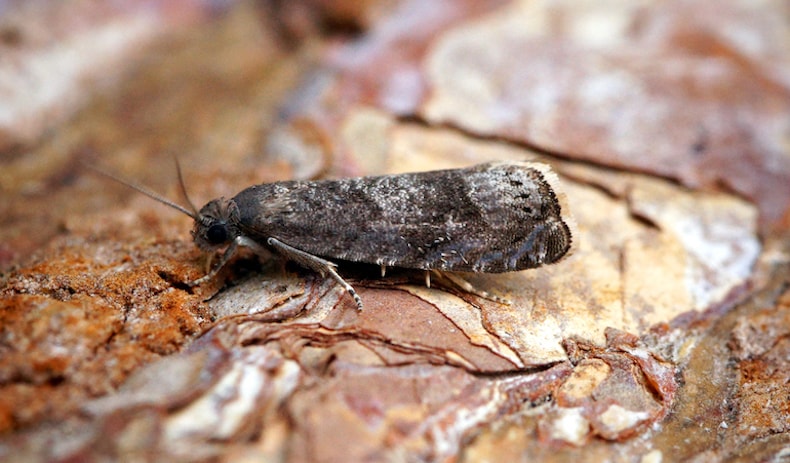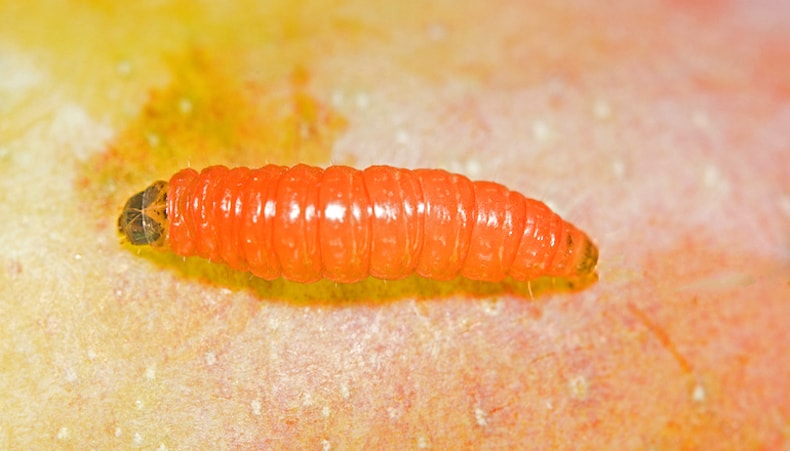Garden pests - Plum fruit moth

Plum fruit moths are a common problem for UK gardeners
Image: Ben Sale from UK, CC BY 2.0 via Wikimedia Commons
If you have a plum tree that’s producing slightly misshapen fruits with a black crumbly substance around the stone, chances are that you have plum fruit moths. Here’s how to deal with this common garden pest.
What are plum fruit moths?
Plum fruit moths are a common UK pest. Their larvae feed on the fruit of the plum tree during the summer months (from late May onwards). Newly-hatched moth larvae tunnel through the fruit, often near the stem, in order to feed around the stone.
Once the caterpillars are fed, they overwinter in the tree itself, tucking themselves away in areas of loose bark until the adult moths appear in May. But particularly warm summers may encourage a second generation.
Despite what their plant-specific name might suggest, these little caterpillars will also happily set up residence in damsons and gages.
How do I know if I have plum fruit moths?

Plum fruit moth larvae are small and brightly coloured
Image: Muddy knees/Shutterstock
There are a few signs of a plum fruit moth infestation – the most obvious of which is catching the plum-eating caterpillars in the act. They are pale pink with a brown head, and are often just over 1cm in size. But they also leave behind a tell-tale trail of black crumbly waste around the stone.
Infested fruits will look slightly misshapen from the outside, and may ripen early.
How can I control the spread of plum fruit moths?

Disrupt the life cycle of plum fruit moths by using a regular fly trap
Image: Greenhouse Fly Catchers from Thompson & Morgan
Here’s how to combat a plum fruit moth infestation:
- Get rid of any infested fruit – including fallen fruit. Otherwise the caterpillars drop from the fruits to the ground and overwinter in the soil beneath the tree, continuing the cycle.
- Eliminate places for the larvae to overwinter by clearing away debris and loose bark from the base of the plum trees.
- Lightly disturb the soil around the base of the tree in early March and again in April to disturb the pupae; hopefully they will be eaten by birds.
- Encourage insect-eating birds to the area using feeders and nest boxes. Bluebirds and swallows particularly like moths, while grosbeaks and orioles will go after the larvae.
- Trap the adult moths before they mate using fly traps or special pheromone traps that will not impact beneficial insects. Pheromone traps, for example, catch male moths, which should mean fewer fertile eggs are laid. Adult moths lay their eggs in June and July, and you can hang traps in the trees from May to August. If you catch large numbers, then it may be necessary to spray with an appropriate insecticide.
- Spray with an insecticide around the third week of June if the other methods haven’t proved successful, and then again a few weeks later. If you use a pheromone trap, you should be able to calculate the most effective time to spray. Just be sure to not spray plants that are in flower.
Visit our comprehensive hub page for further guidance and expert advice on growing fruit trees.
Other pages you might like
See all pests & diseases guides
Individual guides
Pests
Sign Up For Exclusive Special Offers




© 2024 Thompson & Morgan. All rights reserved. A division of Branded Garden Products Limited.



